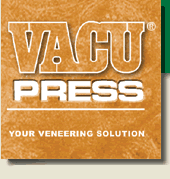Bruce Berman

Posts: 20
Joined: 2005-06-01
Location: Pittsburgh, Pa., USA
 User Profile User Profile |
Michael,
I'm not sure of your terminolgy but if your template is actually your bending form for laminating your curved doors then the answer is yes. Generally one wants to have the form with the cocave side (crown) side up inside the bag. If your bending form does not extend to support the entire surface of the curved door panel then it should be expanded so that the entire curved panel is supported. If the sides of the supporting form are all solid with rounded edges it is better for your vacuum bag. You might also want to cover the form in vinyl film to avoid glue drips.
You can use an extra piece of the 1/8 poplar ply wrapped in vinyl film as your top top caul taking care to tape it into place securely with some duct tape at the begining and end of the curve - not the sides of the curve. You also don't want the veneer extending beyond the caul if possible.
If you are going to veneer the inside of the curved panels, then you should make sure that the top surface of your bending form- now veneering form - is a smooth stiff solid curved panel, preferably 3/4" thick and not open ribs. If this is not the case you can make up such a surface by gluing up a new core panel to act as a bottom caul. You can now veneer the inside surface of your curve usung the same form. Remember to cover it with vinyl film. If you had to add a surface to your form you might see the curved panel spread a little under vacuum. As long as your curve is not too tight and doors are not very thich the panel will spring back after it is removed from the press.
Note than some people have had success veneering curved panels in a vacuum bag letting the bag freely compress around the panel. We have found this approach to be a little too tricky to control especially with veneer movement.
Bruce Berman
Miracle Veneer Trimmer
|





